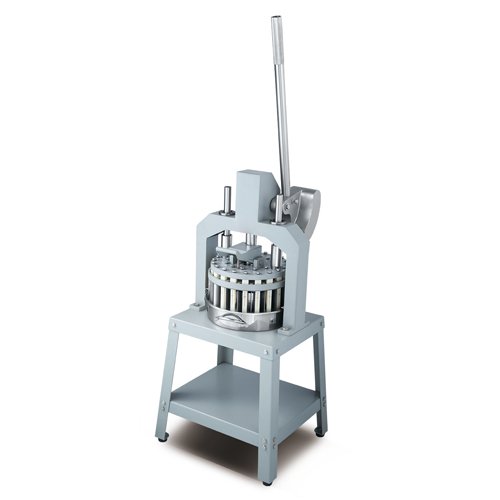
For any food business built on fresh dough, consistency is not just a goal; it’s the foundation of your reputation. Manually portioning dozens or hundreds of dough balls is time-consuming and prone to variation. A commercial manual dough divider is the definitive solution, engineered to deliver precise, uniform portions with remarkable efficiency, streamlining your entire production process.
What is a Commercial Manual Dough Divider?
A commercial manual dough divider is a robust piece of foodservice equipment designed for one critical task: to quickly and accurately divide a large batch of dough into multiple smaller, equal-weight portions. This model, for instance, transforms a single dough mass into 36 perfectly uniform pieces, with each piece weighing between 30g and 180g depending on the initial batch size.
How It Works: The operator places a pre-weighed bulk of dough onto the machine’s tray, pulls a lever, and a set of cutting blades presses down, dividing the dough in a single, swift action.
The Key Difference: This method eliminates the guesswork and tedious labor of weighing and cutting each portion by hand.
Here’s a clear comparison with traditional hand-scaling:
| Feature | Commercial Manual Dough Divider | Manual Portioning (Hand & Scale) |
|---|---|---|
| Action | A single pull of a lever divides the entire batch at once. | Repetitive process: cut, weigh, adjust, repeat for each piece. |
| Best For | High-volume, consistent output (buns, rolls, pizza). | Low-volume or highly variable portion sizes. |
| Speed | Substantial improvement in speed; divides a batch in seconds. | Time-intensive and labor-heavy. |
| Consistency | Exceptionally high consistency; every piece is uniform. | Prone to human error and variation between portions. |
Where Can a Manual Dough Divider Be Used?
This tool is a game-changer in any professional kitchen where dough portioning is a daily task.
- Bakeries: Essential for producing consistent dinner rolls, buns, and small bread loaves.
- Pizzerias: Dramatically speeds up the process of portioning dough balls for pizza bases.
- Restaurants & Hotels: Ensures every bread basket has perfectly uniform rolls, enhancing the dining experience.
- Catering Operations: Guarantees consistent product size for large-scale events and contracts.
- Donut & Pastry Shops: Ideal for creating uniform bases for a wide variety of sweet goods.
Why Should You Choose a Manual Dough Divider?
Integrating a manual dough divider into your workflow provides immediate and tangible advantages for your business.
✅ Guaranteed Portion Consistency: Delivers identical dough portions every single time, which leads to uniform baking and a more professional final product.
✅ Significant Efficiency Gains: Radically reduces the time and labor spent on dough scaling, freeing up staff for other valuable tasks.
✅ Streamlined Kitchen Workflow: Simplifies a key production bottleneck, creating a smoother, faster, and more organized dough preparation process.
✅ Reliable and Durable: With a simple mechanical design, these machines are exceptionally durable, easy to operate, and require minimal maintenance.
How Do You Properly Operate a Manual Dough Divider?
Achieving perfect results is straightforward. Follow these steps for safe and effective operation.
Step-by-Step Guide:
- Prepare the Dough: Weigh your bulk dough batch to the total required weight (e.g., for 100g portions, use a 3.6kg dough ball: 100g x 36 pieces). Lightly flour the dough ball.
- Position the Dough: Place the rounded dough ball in the center of the divider pan.
- Activate the Divider: Pull the handle down firmly. This action presses and cuts the dough into 36 equal portions.
- Remove Portions: Raise the handle and remove the tray of perfectly divided dough pieces.
Best Practices:
- Safety First: Keep hands clear of the cutting head during operation.
- Proper Flour Dusting: Lightly dust the cutting blades and presser head to prevent sticking.
- Regular Cleaning: Clean the head, blades, and pan after use to maintain hygiene and performance, in compliance with relevant regulations.
What Should You Consider When Choosing a Manual Dough Divider?
Use this checklist to ensure the model you select is the right fit for your operational needs.
☐ Division & Weight Range: Does the machine produce the correct number of pieces (e.g., 36) and accommodate your target portion weight (e.g., 30g-180g)?
☐ Build Quality: Is the unit constructed from professional-grade, food-safe materials for long-term durability in a commercial environment?
☐ Ease of Use & Cleaning: Is the design intuitive? Can it be cleaned efficiently to meet food safety standards?
☐ Footprint & Stability: Does the divider fit in your designated workspace, and is it built to be stable during operation?
In conclusion, a commercial manual dough divider is a fundamental investment in quality and efficiency. For any business that prides itself on consistent, high-quality baked goods, this tool moves beyond being a convenience and becomes an operational necessity. By ensuring every portion is perfect from the start, you are setting the stage for a superior final product that keeps customers coming back.
Ready to bring unparalleled consistency to your kitchen? Explore our selection of professional-grade manual dough dividers or contact an equipment specialist to find the perfect match for your business.

